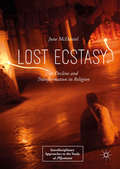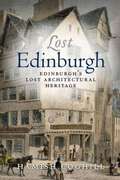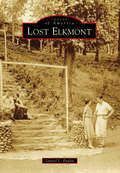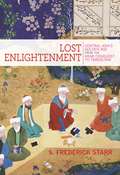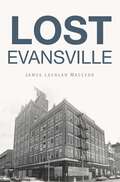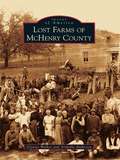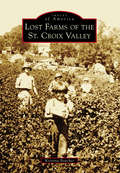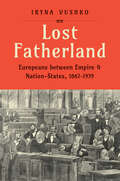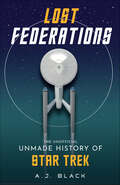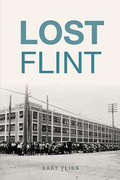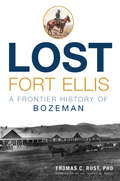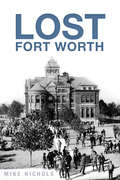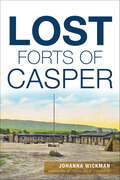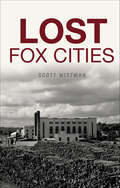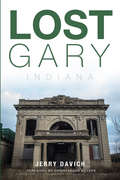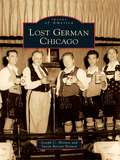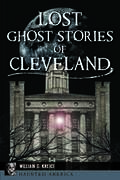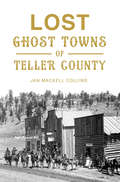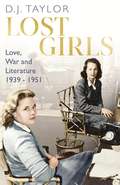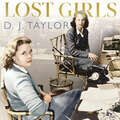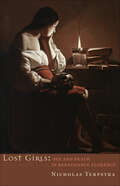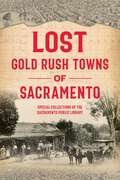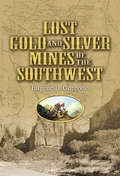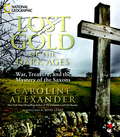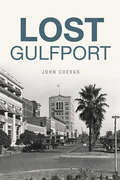- Table View
- List View
Lost Ecstasy: Its Decline and Transformation in Religion (Interdisciplinary Approaches to the Study of Mysticism)
by June McDanielThis book is a study of religious ecstasy, and the ways that it has been suppressed in both the academic study of religion, and in much of the modern practice of religion. It examines the meanings of the term, how ecstatic experience is understood in a range of religions, and why the importance of religious and mystical ecstasy has declined in the modern West. June McDaniel examines how the search for ecstatic experience has migrated into such areas as war, terrorism, transgression, sexuality, drug use, and anti-institutional forms of spirituality. She argues that the loss of religious and mystical ecstasy, as both a religious goal and as a topic of academic study, has had wide-ranging negative effects. She also proposes that the field of religious studies must go beyond criminalizing, trivializing and pathologizing ecstatic and mystical experiences. Both religious studies and theology need to take these states seriously as important aspects of lived human experience.
Lost Edinburgh: Edinburgh's Lost Architectural Heritage (The Lost History Series)
by Hamish CoghillAn exploration of the stories behind the many buildings lost to history in Scotland&’s capital city. What happened to Edinburgh&’s once notorious but picturesque Tolbooth Prison? Where was the Black Turnpike, once a dominant building in the town? Why has one of the New Town designer&’s major layouts been all but obliterated? What else has been lost in Edinburgh? From Edinburgh&’s mean beginnings—&“wretched accommodation, no comfortable houses, no soft beds,&” visiting French knights complained in 1341—it went on to attract some of the world&’s greatest architects to design and build and shape a unique city. But over the centuries many of those fine buildings have gone. Some were destroyed by invasion and civil strife, some simply collapsed with old age and neglect, and others were swept away in the &“improvements&” of the nineteenth century. Yet more fell to the developers&’ swathe of destruction in the twentieth century. Much of the medieval architecture vanished in the Old Town, Georgian Squares were attacked, Princes Street ruined, old tenements razed in huge slum clearance drives, and once familiar and much-loved buildings vanished. The changing pattern of industry, social habits, health service, housing, and road systems all took their toll; not even the city wall was immune. The buildings that stood in the way of what was deemed progress are the heritage of Lost Edinburgh. In this informative book, author Hamish Coghill sets out to trace many of the lost buildings and find out why they were doomed. Lavishly illustrated, Lost Edinburgh is a fascinating insight into an ever-changing cityscape.
Lost Elkmont (Images of America)
by Daniel L. PaulinPrior to the formation of the Great Smoky Mountains National Park (GSMNP) in 1934, the small community of Elkmont was established as a logging camp by Col. Wilson B. Townsend's Little River Lumber Company around 1908. This was after he purchased 86,000 acres of mostly virgin forest. The area that was previously inhabited by various American Indian groups, and later by European-American settlers beginning around 1830, was to become for a time the second largest town in Sevier County, Tennessee. Colonel Townsend's business ventures proved successful beyond expectation, as he skillfully exploited the area's valuable hardwood forests. His logging company and railroad provided a mountain population with jobs and steady wages. Once all the valuable timber was harvested, Townsend sold land to private citizens who established what was to become an exclusive summer community that included both the Appalachian and Wonderland Clubs. These coexisted inside the GSMNP until 1992. This is the story of Elkmont.
Lost Enlightenment: Central Asia's Golden Age from the Arab Conquest to Tamerlane
by S. Frederick StarrIn this sweeping and richly illustrated history, S. Frederick Starr tells the fascinating but largely unknown story of Central Asia's medieval enlightenment through the eventful lives and astonishing accomplishments of its greatest minds--remarkable figures who built a bridge to the modern world. Because nearly all of these figures wrote in Arabic, they were long assumed to have been Arabs. In fact, they were from Central Asia--drawn from the Persianate and Turkic peoples of a region that today extends from Kazakhstan southward through Afghanistan, and from the easternmost province of Iran through Xinjiang, China.Lost Enlightenment recounts how, between the years 800 and 1200, Central Asia led the world in trade and economic development, the size and sophistication of its cities, the refinement of its arts, and, above all, in the advancement of knowledge in many fields. Central Asians achieved signal breakthroughs in astronomy, mathematics, geology, medicine, chemistry, music, social science, philosophy, and theology, among other subjects. They gave algebra its name, calculated the earth's diameter with unprecedented precision, wrote the books that later defined European medicine, and penned some of the world's greatest poetry. One scholar, working in Afghanistan, even predicted the existence of North and South America--five centuries before Columbus. Rarely in history has a more impressive group of polymaths appeared at one place and time. No wonder that their writings influenced European culture from the time of St. Thomas Aquinas down to the scientific revolution, and had a similarly deep impact in India and much of Asia.Lost Enlightenment chronicles this forgotten age of achievement, seeks to explain its rise, and explores the competing theories about the cause of its eventual demise. Informed by the latest scholarship yet written in a lively and accessible style, this is a book that will surprise general readers and specialists alike.
Lost Evansville (Lost)
by Dr. James MacLeodFrom the Wabash and Erie Canal to the Faultless Caster Factory, Evansville has seen much of its history disappear. In the early twentieth century, vestiges of old Evansville like the B'nai Israel temple and Coal Mine Hill gave way to a modern city. Numerous changes in the thirty years following World War II altered the physical appearance of the city, including the removal of the old Central High School, Assumption Cathedral, Gear Town, and more. Less physical but nevertheless vital history like the struggle over Civil Rights in Evansville has been overlooked and, until now, lost. Weaving together a captivating fast-paced account illustrated with over eighty images, award-winning Evansville historian Dr James MacLeod tells the fascinating story of what was lost, what came in its place, and what was preserved against the odds.
Lost Farms of McHenry County
by Arabella Anderson Glynnis WalkerFarmers from the East found the broad and fertile prairies of McHenry County offered the perfect soil and climate for growing corn, wheat, oats, barley, and rye. This led the way for a flourishing dairy industry that eventually supplied milk to the city of Chicago. The first settlements appeared in 1835 in towns such as Crystal Lake, Woodstock, Harvard, and Cary. Families such as the Walkups, the Crandalls, the Beardsleys, the Stickneys, and the Terwilligers travelled by oxcart and rode on horseback from distant states. As word of the lush countryside spread, other farmers came from England, Ireland, and Germany to plow the fertile fields of the nation's heartland.
Lost Farms of the St. Croix Valley (Images of America)
by Kristina BoucherThe St. Croix Valley has been a haven for farmers since the first boom in the 1850s. The St. Croix River was a mecca for early industry, and the vast Minnesota and Wisconsin prairies have provided the natural resources for the region’s farmers to grow their crops and their families. The valley was dotted with brightly painted barns, a sign of economic success. However, as time wore on, the St. Croix Valley experienced an agricultural downturn. Barns have been left abandoned. Fields have been turned into subdivisions. An era has passed, and the barns and farms that were once proud reminders of the region’s success are disappearing from the countryside. But why? Lost Farms of the St. Croix Valley explores the history of the region, shares the photographs and stories of local farmers, and evaluates why the traditional family farm is falling by the wayside.
Lost Fatherland: Europeans between Empire and Nation-States, 1867-1939
by Iryna VushkoHow the demise of the Habsburg Empire, postwar sovereignty, and new diplomatic frontiers shaped the nature of citizenship, identity, and belonging across Europe This book is a collective portrait of twenty-one key statesmen who came of age during the Habsburg Empire. They include the cofounder of Austro-Marxism and the Austrian republic&’s first foreign minister, the cofounder of the European Union after the Second World War, the founder of the Communist Party of Czechoslovakia, and Mussolini&’s ambassador to Vienna. Some survived the First World War and the resulting geographical divisions in their homelands, and some went on to serve in politics and governments throughout Europe. Taken together, the stories of these men offer readers a window on broad issues of European history in the late nineteenth and early twentieth centuries—chiefly, how an imperial heritage, a shared vision of statehood and nationalism, and a commitment to peaceful conflict resolution helped establish enduring loyalty and unity despite the geographical fault lines resulting from the war. As Iryna Vushko explains, their stories also offer an increasingly nuanced understanding of the achievements and failures of the Habsburg Empire.
Lost Federations: The Unofficial Unmade History of Star Trek
by A. J. Black"An innovative and unusual account of Star Trek’s lost voyages that makes for a fascinating alternate history." — Brian J. Robb in Sci-Fi Bulletin SPACE. THE FINAL FRONTIER. THESE WERE ALMOST THE VOYAGES OF THE STARSHIP ENTERPRISE. We think we know the history of Star Trek. Born at the height of 1960s popular culture, the five-year mission of Captain James T. Kirk and his crew faced early cancellation, bounced back with a series of beloved movies in the 1980s and gave way to a fleet of successful sequels and spin-offs that kept on exploring strange new worlds. In Lost Federations: The Unofficial Unmade History of Star Trek, author A. J. Black tells a different story. This is an alternate history of the franchise, one filled with roads not taken, from early 1960s feature-films and spin-offs, the original sequel Star Trek: Phase II in the 1970s, via epic planned movies such as Planet of the Titans and into many untold episodes, arcs and character stories from The Next Generation, Deep Space Nine and Voyager, all the way through to the modern era. Bringing together pre-existing material over decades for the first time in one space, plus some new reflections from Star Trek writers and analysis of how it all fits into the wider cultural trends of the last sixty years, Lost Federations invites you to boldly explore a history you may not already know...
Lost Flint (Lost)
by Gary FlinnThe city of Flint waxed and waned with the automotive industry of the twentieth century. Where they have not vanished completely, crumbling signs of past opulence stand as painful reminders of more recent struggles. Hardly a trace remains of the Buick City factory complex that sprawled across the city's north side. The placid waters of Flint Park Lake once echoed with the sounds of an amusement park--games, dancing, circus acts and even a roller coaster. Flint Community Schools pioneered a model for how schools can function outside regular hours, but too many now are closed and deteriorating. Local author Gary Flinn uncovers the abandoned places and lost traditions from the Vehicle City's past.
Lost Fort Ellis: A Frontier History of Bozeman (Lost)
by Thomas C. Rust Dr Harry FritzEstablished in 1867 in the Gallatin Valley of Montana, Fort Ellis played a key role in the development of the Montana frontier. From post commanders attacking the town to restoring order when riotous mobs got out of control, explore the ambivalent, albeit contentious, relationship from 1867 to 1886 between the civilians and soldiers in whimsical but dramatic fashion. Competing visions of economic and military conditions on the frontier led to a complex relationship that has all the drama of a Hollywood western. Join MSU-Billings history professor Dr. Thomas C. Rust as he examines the fort's impact on the social and economic development of early Bozeman, the problems of military command and the dynamics of the soldier-civilian interaction on Montana's frontier.
Lost Fort Worth (Lost)
by Mike NicholsFrom the humble beginnings of a frontier army camp, Fort Worth transformed into a city as cattle drives, railroads, oil and national defense drove its economy. During the tremendous growth, the landscape and cultural imprint of the city changed drastically, and much of Cowtown was lost to history. Witness the birth of western swing music and the death of a cloud dancer. See mansions of the well-heeled and saloons of the well-armed. Meet two gunfighters, one flamboyant preacher, one serial killer and one very short subway carrying passengers back in time to discover more of Fort Worth. Author Mike Nichols presents a colorful history tour from the North Side to the South Side's Battle of Buttermilk Junction.
Lost Forts of Casper (Lost)
by Johanna WickmanThree army outposts built before and during the Civil War protected critical routes along the western trails at the North Platte River near what later became Casper. All had been abandoned by 1867, and their dramatic stories are mostly forgotten. The Post at Platte Bridge was a vital outpost on Albert Sidney Johnston's Utah War supply route. Camp Dodge and Platte Bridge Station, also called Fort Caspar, guarded telegraph lines from Native American sabotage. Violent winds, horrendous blizzards and scorching summers made life miserable. Tension reached a fever pitch at the Battle of Platte Bridge when Sioux, Cheyenne and Arapaho attacked a cavalry detachment led by Caspar Collins. Today, a reconstructed Fort Caspar stands as a vigilant reminder of the struggles at those lonely frontier stations. Local historian Johanna Wickman chronicles military efforts to keep the peace, wage war and merely survive.
Lost Fox Cities (Lost)
by Scott WittmanThe lumber kings and paper barons of the Fox River Valley transformed a wilderness of vast, rich timberlands and raging river waters into empires of pine, paper and power. In Oshkosh, lumber dynasties such as Paine and Morgan helped rebuild a nation ravaged by fire and war. Four young Neenah entrepreneurs with no experience in papermaking formed Kimberly-Clark, one of the largest paper manufacturers in the world. H.J. Rogers of Appleton watched his home light up the night after he wired it with Edison's electric lightbulbs, the first in the world to do so utilizing hydroelectricity. These men ushered in an era of opulence shining with steamboat excursions along the river, palatial mansions in plush neighborhoods and lavish hotels and movie houses. Much of this bygone age now exists only in photographs, written accounts or memories. Local photographer and historian Scott Wittman recovers this vanishing history.
Lost Gary, Indiana (Lost)
by Jerry DavichA poster child for our nation's urban experimentation a century ago, Gary was forged with hype and hope, dreams and sweat, political agendas and tons of steel. The hardscrabble city attracted all kinds, from shady scoundrels and famous architects to hardworking immigrants and brilliant entrepreneurs. Boasting 180,000 residents at its peak, the booming melting pot eventually faded away under the afflictions of urban decay, racial unrest and political upheaval. Jerry Davich explores the remnants of Gary's glory days, from Union Station in ruins to City Methodist Church stripped of its soul. Revisit the Sheraton Hotel's demise, Emerson High School's hard lessons, Vee-Jay Records' last release and a devastated downtown filled only with façades and fond memories.
Lost German Chicago (Images of America)
by Joseph C. Heinen Susan Barton HeinenBy 1900, one in four Chicagoans was either German born or had a German-born parent. No other ethnic group's thumbprint has been larger in helping establish Chicago as a major economic and cultural center nor has any group's influence been more erased by the passage and vicissitudes of time. Lost German Chicago traces the mosaic of German life through the tumultuous events of the Beer Riots, Haymarket Affair, Prohibition, and America's entry into two world wars. The book is a companion piece to the Lost German Chicago exhibition debuting in the newly created DANK-Haus German American Cultural Center museum, located in what is still known today as the "German town" of the north side of Chicago. Entrusted as the caretaker of many archives, artifacts, and historical documents from many now defunct German organizations, the DANK-Haus German American Cultural Center has been committed to preserving history, traditions, and contributions of Germans and German Americans for over 50 years.
Lost Ghost Stories of Cleveland (Haunted America)
by William G. KrejciRediscover Cleveland's Forgotten Hauntings Hiding in obscure corners and in plain sight, chilling tales from Cleveland's paranormal past await reawakening. A tale from 1840 places the city's first haunted house on the windswept commons south of town. Hanged murderers were said to roam the corridors of the Old County Jail, and t he 1885 disinterment of the old Cleveland Medical College graveyard led to reports of nocturnal phantoms throughout the excavation. With the construction of Bulkley Boulevard in 1912, many West Side homes were demolished. Also destroyed was the entrance to what neighbors menacingly called The Cave of Apparitions. Take a step back in time with author and investigative historian William G. Krejci on this journey through Cleveland's long lost ghostly past.
Lost Ghost Towns of Teller County (Lost)
by Jan Mackell CollinsThroughout Teller County, history lovers can find abandoned towns and forgotten main streets that once bustled with life and commerce. Even before Teller was carved from surrounding counties, the scenic mountains and lucrative mines of the gold rush era brought thousands of settlers and attracted resort owners and tycoons eager to exploit the rich setting. Seemingly overnight, towns in the Cripple Creek District and other places popped up, flush with gold and people looking for opportunity. As the ore disappeared, the miners moved on in search of the next big lode. One by one, the towns were all but forgotten. Join Jan MacKell Collins and discover the booming history, lost towns and hardy settlers of Teller County.
Lost Girls: Love, War and Literature: 1939-51
by D.J. TaylorA Times Book of the Year 2019'You should not deny yourself the pleasure of reading it' Sunday Times'A remarkable work and an important addition to the extraordinary wartime history of literary London' Literary ReviewWho were the Lost Girls? At least a dozen or so young women at large in Blitz-era London have a claim to this title. But Lost Girls concentrates on just four: Lys Lubbock, Sonia Brownell, Barbara Skelton and Janetta Parlade. Chic, glamorous and bohemian, as likely to be found living in a rat-haunted maisonette as dining at the Ritz, they cut a swathe through English literary and artistic life in the 1940s. Three of them had affairs with Lucian Freud. One of them married George Orwell. Another became the mistress of the King of Egypt and was flogged by him on the steps of the Royal Palace. And all of them were associated with the decade's most celebrated literary magazine, Horizon, and its charismatic editor Cyril Connolly. Lys, Sonia, Barbara and Janetta had very different - and sometimes explosive personalities - but taken together they form a distinctive part of the war-time demographic: bright, beautiful, independent-minded women with tough upbringings behind them determined to make the most of their lives in a highly uncertain environment. Theirs was the world of the buzz bomb, the cocktail party behind blackout curtains, the severed hand seen on the pavement in the Bloomsbury square, the rustle of a telegram falling through the letter-box, the hasty farewell to another half who might not ever come back, a world of living for the moment and snatching at pleasure before it disappeared. But if their trail runs through vast acreages of war-time cultural life then, in the end, it returns to Connolly and his amorous web-spinning, in which all four of them regularly featured and which sometimes complicated their emotional lives to the point of meltdown.The Lost Girls were the product of a highly artificial environment. After it came to an end - on Horizon's closure in 1950 - their careers wound on. Later they would have affairs with dukes, feature in celebrity divorce cases and make appearances in the novels of George Orwell, Evelyn Waugh, Anthony Powell and Nancy Mitford. The last of them - Janetta - died as recently as three months ago. However tiny their number, they are a genuine missing link between the first wave of newly-liberated young women of the post-Great War era and the Dionysiac free-for-all of the 1960s. Hectic, passionate and at times unexpectedly poignant, this is their story.
Lost Girls: Love, War and Literature: 1939-51
by D.J. TaylorA Times Book of the Year 2019'You should not deny yourself the pleasure of reading it' Sunday Times'A remarkable work and an important addition to the extraordinary wartime history of literary London' Literary ReviewWho were the Lost Girls? At least a dozen or so young women at large in Blitz-era London have a claim to this title. But Lost Girls concentrates on just four: Lys Lubbock, Sonia Brownell, Barbara Skelton and Janetta Parlade. Chic, glamorous and bohemian, as likely to be found living in a rat-haunted maisonette as dining at the Ritz, they cut a swathe through English literary and artistic life in the 1940s. Three of them had affairs with Lucian Freud. One of them married George Orwell. Another became the mistress of the King of Egypt and was flogged by him on the steps of the Royal Palace. And all of them were associated with the decade's most celebrated literary magazine, Horizon, and its charismatic editor Cyril Connolly. Lys, Sonia, Barbara and Janetta had very different - and sometimes explosive personalities - but taken together they form a distinctive part of the war-time demographic: bright, beautiful, independent-minded women with tough upbringings behind them determined to make the most of their lives in a highly uncertain environment. Theirs was the world of the buzz bomb, the cocktail party behind blackout curtains, the severed hand seen on the pavement in the Bloomsbury square, the rustle of a telegram falling through the letter-box, the hasty farewell to another half who might not ever come back, a world of living for the moment and snatching at pleasure before it disappeared. But if their trail runs through vast acreages of war-time cultural life then, in the end, it returns to Connolly and his amorous web-spinning, in which all four of them regularly featured and which sometimes complicated their emotional lives to the point of meltdown.The Lost Girls were the product of a highly artificial environment. After it came to an end - on Horizon's closure in 1950 - their careers wound on. Later they would have affairs with dukes, feature in celebrity divorce cases and make appearances in the novels of George Orwell, Evelyn Waugh, Anthony Powell and Nancy Mitford. The last of them - Janetta - died as recently as three months ago. However tiny their number, they are a genuine missing link between the first wave of newly-liberated young women of the post-Great War era and the Dionysiac free-for-all of the 1960s. Hectic, passionate and at times unexpectedly poignant, this is their story.
Lost Girls: Sex and Death in Renaissance Florence
by Nicholas TerpstraIn 1554, a group of idealistic laywomen founded a home for homeless and orphaned adolescent girls in one of the worst neighborhoods in Florence. Of the 526 girls who lived in the home during its fourteen-year tenure, only 202 left there alive. Struck by the unusually high mortality rate, Nicholas Terpstra sets out to determine what killed the lost girls of the House of Compassion shelter (Casa della Pietà). Reaching deep into the archives' letters, ledgers, and records from both inside and outside the home, he slowly pieces together the tragic story. The Casa welcomed girls in bad health and with little future, hoping to save them from an almost certain life of poverty and drudgery. Yet this "safe" house was cruelly dangerous. Victims of Renaissance Florence’s sexual politics, these young women were at the disposal of the city’s elite men, who treated them as property meant for their personal pleasure. With scholarly precision and journalistic style, Terpstra uncovers and chronicles a series of disturbing leads that point to possible reasons so many girls died: hints of routine abortions, basic medical care for sexually transmitted diseases, and appalling conditions in the textile factories where the girls worked. Church authorities eventually took the Casa della Pietà away from the women who had founded it and moved it to a better part of Florence. Its sordid past was hidden, until now, in an official history that bore little resemblance to the orphanage’s true origins. Terpstra’s meticulous investigation not only uncovers the sad fate of the lost girls of the Casa della Pietà but also explores broader themes, including gender relations, public health, church politics, and the challenges girls and adolescent women faced in Renaissance Florence.
Lost Gold Rush Towns of Sacramento (Lost)
by Sacramento Public Library AuthorityThe Cannibal CityIn the early days of the California Gold Rush, Sacramento City had several competing towns vying for the influx of newcomers. Many of its rivals not only had vibrant multicultural communities but also enjoyed superior geography for transportation and flood control. Even the initial land grant from Johann Sutter is considered controversial if not downright fiction, yet Sacramento thrived where others failed. Once-bustling Mormon Island was initially the proposed site of the railway that would end up bypassing it, and Brighton became a hotbed of agitation after the deadly “Squatters’ Riot,” leading to its decline. Hoboken, Prairie City and more were also wiped off the map. The Special Collections of the Sacramento Public Library explores the history of these lost Sacramentos.
Lost Gold and Silver Mines of the Southwest
by Eugene L. ConrottoHandy guide to the long-lost mines, rich veins of ore, silver lodes, buried treasure and other bonanzas. All fully described, including fascinating anecdotes about the treasure, its general locale and other information. Each description also accompanied by a map of the region. 96 maps and over 50 other line illustrations.
Lost Gold of the Dark Ages: War, Treasure, and the Mystery of the Saxons
by Caroline AlexanderIn July 2009 an amateur metal-detecting enthusiast made an astonishing find: 1500 pieces of bejeweled gold and silver almost 1500 years old, buried, lost, then forgotten. The treasure trove promises to shed unprecedented light on the most mysterious period of British history - the so-called Dark Ages - when the Saxons, Anglos, Celts, Picts, Jutes, and Vikings battled for control of the British Isles and "a mish mash of peoples evolved into a homogenous nation possessed with a strong cultural identity," according to New York Times bestselling author of the book, Caroline Alexander. Alexander, author of the bestselling The Endurance and The Bounty, draws themes from the story of the spectacular treasure to explore the entire fascinating history of the Saxons in England; from the fall of Rome to the flourishing and seemingly incomprehensible spread of Saxon influence. Piece by piece, she draws readers into a world of near constant warfare guided by a unique understanding of Christianity, blended as it was with pagan traditions. Through heroic and epic literature that survives in poems such as Beowulf and the Legends of King Arthur, Alexander seeks to separate myth from reality and wonder, with readers, if the circumstances of the deposit of such a spectacular hoard have parallels in legendary tales. Peering through a millennia of mist and mystery, Alexander reveals a fascinating era - and a mesmerizing discovery - as never before, uncovering a dynamic period of history that would see its conclusion in the birth of the English nation.
Lost Gulfport (Lost)
by John CuevasThe second largest city in the state, Gulfport is the business center of south Mississippi. Many of the city's cherished landmarks and businesses have been lost to Hurricanes Camille and Katrina, the development of shopping malls and Interstate 10. Gulfport's answer to the quintessential '50s malt shop, Stone's Ice Cream, became a favorite hangout for students, families and businessmen throughout its long history. The Paramount Theatre was famous for its annual Christmas raffle during the '50s. Known as the "Hosts of the Gulf Coast," the Friendship House Restaurant served up a great cup of coffee along with its celebrated Hospitality Menu. Historian John Cuevas takes a look back at Gulfport's shops, restaurants, nightclubs, cinemas and more from a bygone age.
